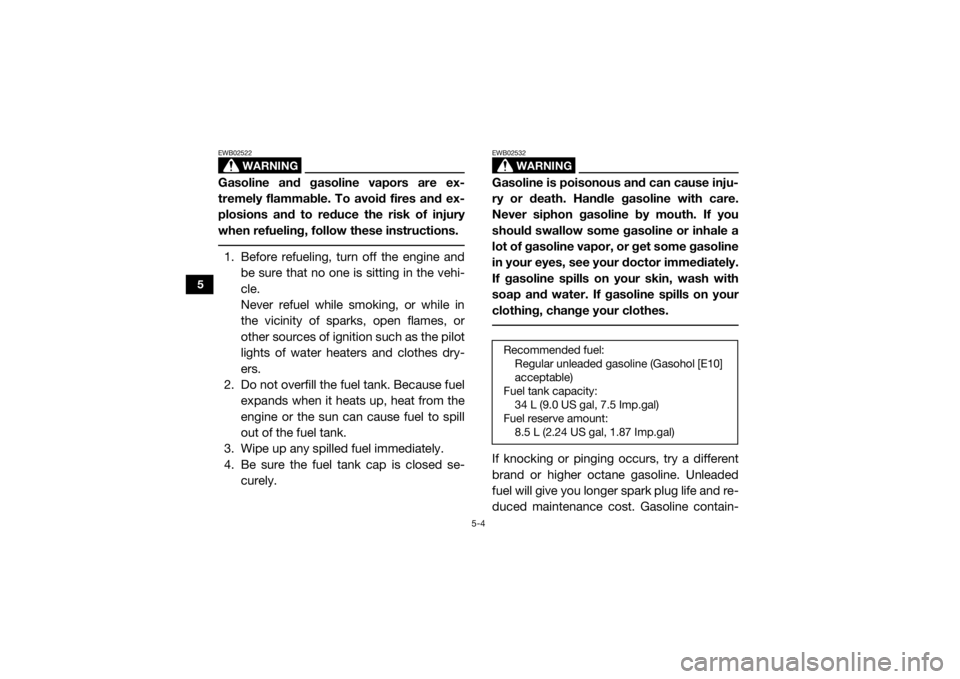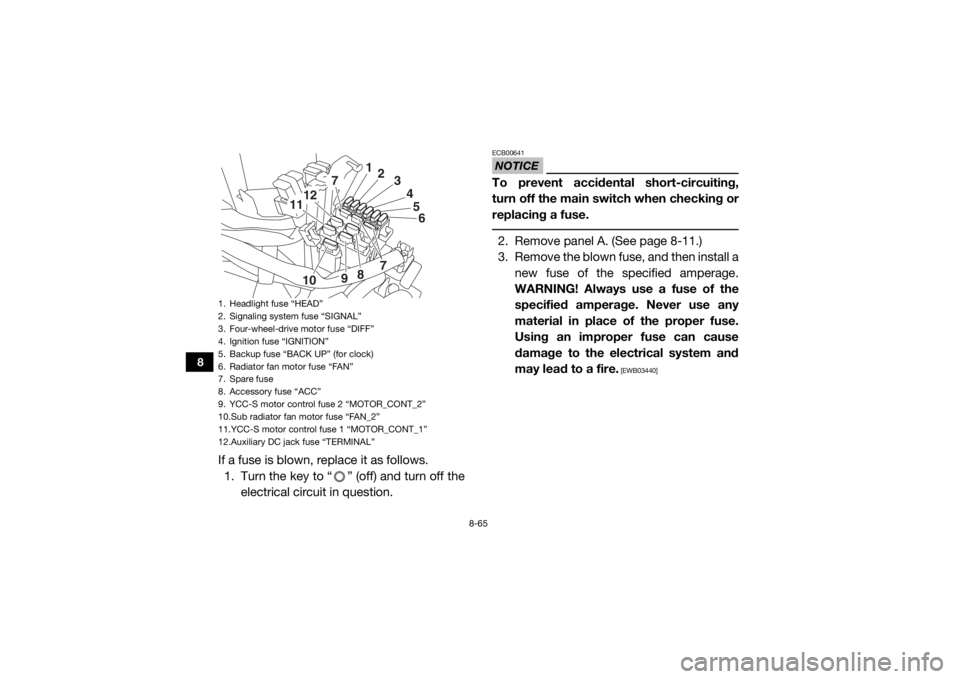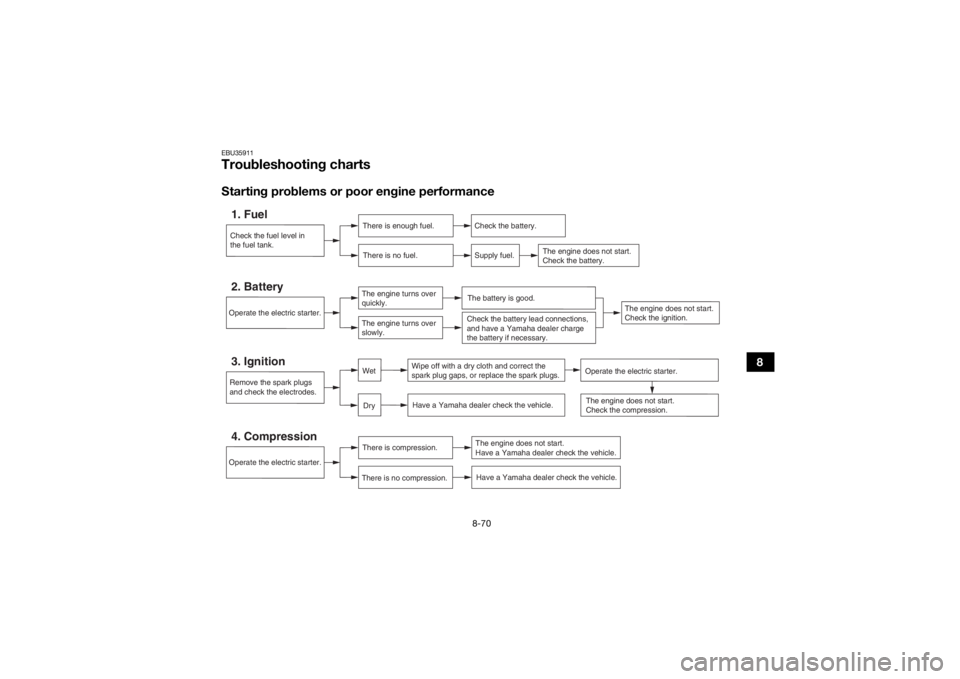ignition YAMAHA YXZ1000R SS 2019 Owners Manual
[x] Cancel search | Manufacturer: YAMAHA, Model Year: 2019, Model line: YXZ1000R SS, Model: YAMAHA YXZ1000R SS 2019Pages: 218, PDF Size: 9.48 MB
Page 90 of 218

5-4
5
WARNING
EWB02522Gasoline and gasoline vapors are ex-
tremely flammable. To avoid fires and ex-
plosions and to reduce the risk of injury
when refueling, follow these instructions. 1. Before refueling, turn off the engine andbe sure that no one is sitting in the vehi-
cle.
Never refuel while smoking, or while in
the vicinity of sparks, open flames, or
other sources of ignition such as the pilot
lights of water heaters and clothes dry-
ers.
2. Do not overfill the fuel tank. Because fuel expands when it heats up, heat from the
engine or the sun can cause fuel to spill
out of the fuel tank.
3. Wipe up any spilled fuel immediately.
4. Be sure the fuel tank cap is closed se-
curely.
WARNING
EWB02532Gasoline is poisonous and can cause inju-
ry or death. Handle gasoline with care.
Never siphon gasoline by mouth. If you
should swallow some gasoline or inhale a
lot of gasoline vapor, or get some gasoline
in your eyes, see your doctor immediately.
If gasoline spills on your skin, wash with
soap and water. If gasoline spills on your
clothing, change your clothes. If knocking or pinging occurs, try a different
brand or higher octane gasoline. Unleaded
fuel will give you longer spark plug life and re-
duced maintenance cost. Gasoline contain-Recommended fuel:Regular unleaded gasoline (Gasohol [E10]
acceptable)
Fuel tank capacity: 34 L (9.0 US gal, 7.5 Imp.gal)
Fuel reserve amount: 8.5 L (2.24 US gal, 1.87 Imp.gal)
UB5H7AE0.book Page 4 Wednesday, July 4, 2018 1:37 PM
Page 111 of 218

7-2
7
As the owner/operator, it is your responsibility
to protect yourself and your passenger from
accidents, including rollovers. The YXZ1000R
has many features, including a protective
structure and seat belts, to help protect occu-
pants, but the best way to avoid injuries is to
avoid accidents. There is a risk of injury or
death in any accident, even with these safety
features.
Driver requirements
This vehicle is intended for use only by an
operator 16 or older with a valid motor ve-
hicle license. Check country laws for mini-
mum age requirements.
The driver must be able to place both feet
flat on the floorboard while seated upright
with his/her back against the backrest.
Do not drive after using drugs or alcohol.
Remove the ignition key when the vehicle is
not in use to prevent unauthorized use of
the machine.
Parents:
Many countries have implemented new mo-
tor vehicle licensing requirements for young
drivers. These requirements are in response
to the disproportionately high rate of crashes
involving youthful drivers. As with automo-
DRIVER
UNDER
16
UB5H7AE0.book Page 2 Wednesday, July 4, 2018 1:37 PM
Page 171 of 218

8-40
8
TIPIf a torque wrench is not available when in-
stalling the spark plug, a good estimate of the
correct torque is 1/4–1/2 turn past finger tight.
However, the spark plug should be tightened
to the specified torque as soon as possible. NOTICEECB02900Do not use any tools to remove or install
the spark plug cap, otherwise the ignition
coil coupler may be damaged. The spark
plug cap may be difficult to remove be-
cause the rubber seal on the end of the cap
fits tightly. To remove the spark plug cap,
simply twist it back and forth while pulling
it out; to install it, twist it back and forth
while pushing it in.
EBU38320Air filter maintenanceThis model is equipped with two air filter ele-
ments, a primary foam-type air filter and a
secondary paper-type air filter.
The primary air filter is easily accessed and
should be cleaned and oiled every 300–600
km (200–400 mi).
The secondary air filter is more difficult to ac-
cess, cannot be cleaned, and should be re-
placed by a Yamaha dealer every 2000–5000
km (1200–3000 mi).1. Primary air filter
2. Secondary air filter
1
2
UB5H7AE0.book Page 40 Wednesday, July 4, 2018 1:37 PM
Page 191 of 218

8-60
8
by the sulfuric acid in battery electrolyte. In
case of accidental contact with battery
electrolyte:
EXTERNAL: Flush with water.
INTERNAL: Drink large quantities of water
or milk. Follow with milk of magnesia,
beaten egg, or vegetable oil. Get prompt
medical attention.
EYES: Flush with water for 15 minutes and
get prompt medical attention.
WARNING
EWB03420Batteries may produce explosive gases.
Ventilate when charging or using in a
closed space. Keep batteries away from
sparks, flames, cigarettes, or other sourc-
es of ignition. To remove the battery1. Turn the key to “ ” (off).
2. Remove panel A. (See page 8-11.) 3. Remove the battery holding plate by re-
moving the bolts.
4. Disconnect the negative battery lead first, then the positive battery lead by remov-
ing their bolt. NOTICE: When removing
the battery, the main switch must be
off, and the negative lead must be dis-
connected before the positive lead.
[ECB01002]
1. Battery holding plate
2. Bolt
1 2
2
UB5H7AE0.book Page 60 Wednesday, July 4, 2018 1:37 PM
Page 196 of 218

8-65
8
If a fuse is blown, replace it as follows.1. Turn the key to “ ” (off) and turn off the electrical circuit in question.
NOTICEECB00641To prevent accidental short-circuiting,
turn off the main switch when checking or
replacing a fuse. 2. Remove panel A. (See page 8-11.)
3. Remove the blown fuse, and then install anew fuse of the specified amperage.
WARNING! Always use a fuse of the
specified amperage. Never use any
material in place of the proper fuse.
Using an improper fuse can cause
damage to the electrical system and
may lead to a fire.
[EWB03440]
1. Headlight fuse “HEAD”
2. Signaling system fuse “SIGNAL”
3. Four-wheel-drive motor fuse “DIFF”
4. Ignition fuse “IGNITION”
5. Backup fuse “BACK UP” (for clock)
6. Radiator fan motor fuse “FAN”
7. Spare fuse
8. Accessory fuse “ACC”
9. YCC-S motor control fuse 2 “MOTOR_CONT_2”
10.Sub radiator fan motor fuse “FAN_2”
11.YCC-S motor control fuse 1 “MOTOR_CONT_1”
12.Auxiliary DC jack fuse “TERMINAL”
56
7
7
12
11
10 98 4
3
2
1
UB5H7AE0.book Page 65 Wednesday, July 4, 2018 1:37 PM
Page 197 of 218

8-66
8
4. Turn the key to “ ” (on) and turn on theelectrical circuit in question to check if
the device operates. If the fuse blows
again immediately, have a Yamaha dealer
check the electrical system.
5. Install the panel.
Specified fuses: Main fuse:50.0 A
Fuel injection system fuse: 15.0 A
Headlight fuse: 15.0 A
Ignition fuse: 15.0 A
Auxiliary DC jack fuse: 10.0 A
Signaling system fuse: 10.0 A
Four-wheel-drive motor fuse: 10.0 A
Sub radiator fan motor fuse: 30.0 A
Radiator fan motor fuse: 30.0 A
Backup fuse: 10.0 A
EPS fuse: 40.0 A
Accessory fuse: 15.0 A
YCC-S motor control fuse:30.0 A
YCC-S motor control fuse_2: 30.0 A
UB5H7AE0.book Page 66 Wednesday, July 4, 2018 1:37 PM
Page 199 of 218

8-68
8
EBU37910Brake/tail lightThis model is equipped with an LED brake/tail
light, there are no replaceable bulbs.
If the brake/tail light does not come on, check
for a loose connection, check the fuses, and
then have a Yamaha dealer check the vehicle.EBU36961Interior lights (for LE models)This model is equipped with LED interior
lights. There are no user replaceable bulbs.
If one or more interior lights do not come on,
check for a loose connection, check the fus-
es, and then have a Yamaha dealer check the
vehicle.EBU32700TroubleshootingAlthough Yamaha vehicles receive an inspec-
tion before shipment from the factory, trouble
may occur during operation. Any problem in
the fuel, compression, or ignition systems can
cause poor starting and loss of power. The
troubleshooting chart describes a quick, easy
1. Headlight beam adjusting screw
1. Headlight beam adjusting screw
(a)
(b)
1
(b)
(a)
1
UB5H7AE0.book Page 68 Wednesday, July 4, 2018 1:37 PM
Page 201 of 218

8-70
8
EBU35911Troubleshooting chartsStarting problems or poor engine performanceCheck the fuel level in
the fuel tank.1. Fuel
There is enough fuel.
There is no fuel.
Check the battery.
Supply fuel.
The engine does not start.
Check the battery.
Operate the electric starter.4. Compression
There is compression.
There is no compression.
The engine does not start.
Have a Yamaha dealer check the vehicle.Have a Yamaha dealer check the vehicle.
Remove the spark plugs
and check the electrodes.3. Ignition
Wipe off with a dry cloth and correct the
spark plug gaps, or replace the spark plugs.
Have a Yamaha dealer check the vehicle.
The engine does not start.
Check the compression.
Operate the electric starter.2. Battery
The engine turns over
quickly.
The engine turns over
slowly.
The battery is good.
DryWet
Operate the electric starter.
Check the battery lead connections,
and have a Yamaha dealer charge
the battery if necessary.
The engine does not start.
Check the ignition.
UB5H7AE0.book Page 70 Wednesday, July 4, 2018 1:37 PM
Page 210 of 218

10-5
10
Rear suspension:Type:Double wishbone
Spring:
Coil spring
Shock absorber: Gas-hydraulic damper
Wheel travel: 432 mm (17.0 in)Electrical system:System voltage:12 V
Ignition system: TCI
Charging system:
AC magnetoBattery:Model:U1-H11L
Voltage, capacity:
12 V, 28.0 AhLights:Headlight:LED
Brake/tail light:
LED
Auxiliary light: LED [YXZ10YESK (LE model)]
Interior light: LED [YXZ10YESK (LE model)] Meter lighting:
LED
Neutral indicator light: LED
High beam indicator light:
LED
Reverse indicator light: LED
Coolant temperature warning light: LED
Parking brake indicator light:
LED
Engine trouble warning light: LED
Differential gear lock indicator light: LED
EPS warning light:
LED
Helmet reminder light: 0.8 W
Seat belt reminder light: 0.8 W
Shift timing indicator light:
LED
Half clutch indicator light: LED
Launch system indicator light: LED
YCC-S system warning light:
LED
UB5H7AE0.book Page 5 Wednesday, July 4, 2018 1:37 PM
Page 211 of 218

10-6
10
Fuses:Main fuse:50.0 A
Fuel injection system fuse:
15.0 A
EPS fuse: 40.0 A
Headlight fuse: 15.0 A
Signaling system fuse:
10.0 A
Ignition fuse: 15.0 A
Auxiliary DC jack fuse: 10.0 A
Accessory fuse:
15.0 A
YCC-S motor control fuse: 30.0 A
YCC-S motor control fuse_2: 30.0 A
Backup fuse:
10.0 A
Four-wheel-drive motor fuse: 10.0 A
Radiator fan motor fuse: 30.0 A
Sub radiator fan motor fuse:
30.0 A
EBU36980The figures quoted are emission levels and
are not necessarily safe working levels. Whilst
there is a correlation between the emission
and exposure levels, this cannot be used reli-
ably to determine whether or not further pre-
cautions are required. Factors that influence
the actual level of exposure of work-force in-
clude the characteristics of the work room,
the other sources of noise, etc. i.e. the num-
ber of machines and other adjacent process-
es, and the length of time for which an
operator is exposed to the noise. Also the
permissible exposure level can vary from
country. This information, however, will en-
able the user of the machine to make a better
evaluation of the hazard and risk.
UB5H7AE0.book Page 6 Wednesday, July 4, 2018 1:37 PM